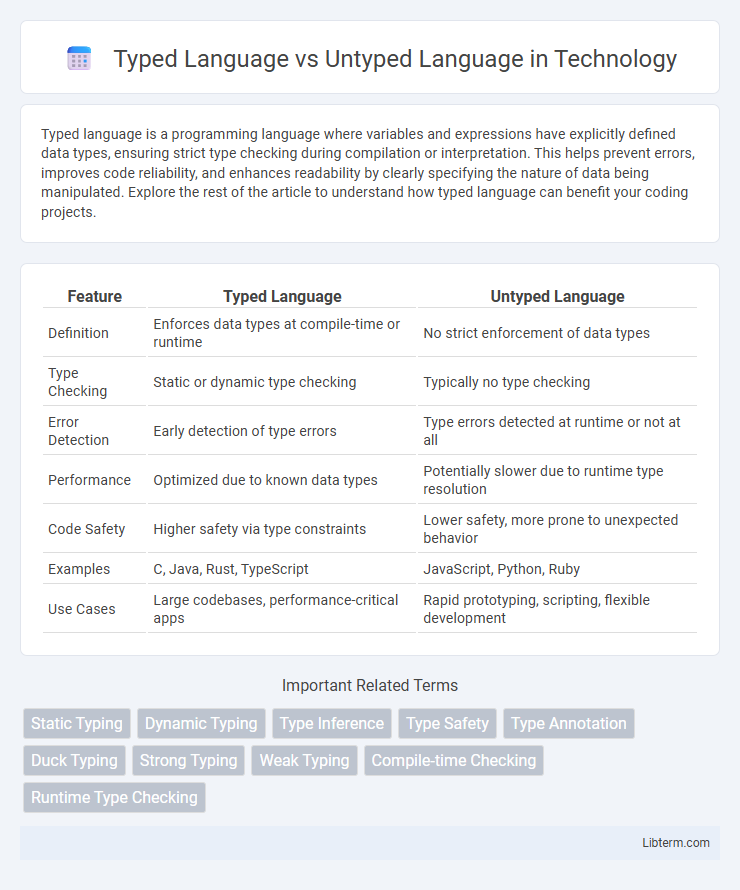Typed language is a programming language where variables and expressions have explicitly defined data types, ensuring strict type checking during compilation or interpretation. This helps prevent errors, improves code reliability, and enhances readability by clearly specifying the nature of data being manipulated. Explore the rest of the article to understand how typed language can benefit your coding projects.
Table of Comparison
| Feature | Typed Language | Untyped Language |
|---|---|---|
| Definition | Enforces data types at compile-time or runtime | No strict enforcement of data types |
| Type Checking | Static or dynamic type checking | Typically no type checking |
| Error Detection | Early detection of type errors | Type errors detected at runtime or not at all |
| Performance | Optimized due to known data types | Potentially slower due to runtime type resolution |
| Code Safety | Higher safety via type constraints | Lower safety, more prone to unexpected behavior |
| Examples | C, Java, Rust, TypeScript | JavaScript, Python, Ruby |
| Use Cases | Large codebases, performance-critical apps | Rapid prototyping, scripting, flexible development |
Introduction to Typed and Untyped Languages
Typed languages enforce variable data types during compilation or interpretation, ensuring type safety and reducing runtime errors by catching mismatches early. Untyped languages allow variables to hold any type of data without explicit type declarations, providing flexibility but increasing the risk of runtime type-related errors. Understanding the distinction between typed and untyped languages is crucial for selecting the appropriate programming paradigm based on application requirements and development goals.
Defining Typed Languages
Typed languages enforce strict rules on variable data types, ensuring that each variable is explicitly declared with a specific type such as integer, string, or boolean. This type discipline enables early error detection during compilation, improving code reliability and maintainability by preventing type-related runtime errors. Languages like Java, C++, and TypeScript exemplify typed languages, offering strong static typing that enhances developer productivity and software robustness.
Understanding Untyped Languages
Untyped languages, such as Assembly and many scripting languages like JavaScript before strict mode, do not enforce variable data types, allowing dynamic and flexible code manipulation at runtime. This flexibility enhances rapid prototyping and ease of use but can lead to runtime errors due to type mismatches, as there is no compile-time type checking to catch errors early. Understanding untyped languages requires familiarity with dynamic typing principles, memory management implications, and effective debugging techniques to mitigate risks associated with type-related errors.
Key Differences Between Typed and Untyped Languages
Typed languages enforce strict data type constraints at compile-time or run-time, enabling early error detection and improved code reliability. Untyped languages, such as JavaScript or Python, offer greater flexibility by allowing variables to hold any data type, but this can lead to runtime errors and harder debugging. The key difference lies in type safety and error management: typed languages provide type checks to prevent invalid operations, while untyped languages sacrifice this for dynamic typing and rapid development.
Advantages of Typed Languages
Typed languages provide increased code reliability by enforcing strict type-checking at compile time, which helps prevent common programming errors such as type mismatches and unintended data manipulation. They improve code readability and maintainability by clearly defining variable types, enabling better documentation and easier debugging. Enhanced tooling support, including intelligent code completion and refactoring capabilities, is another advantage, as it leverages type information to streamline development processes.
Benefits of Untyped Languages
Untyped languages offer greater flexibility and faster prototyping capabilities by allowing developers to write code without strict type constraints, which accelerates the development process. These languages enable dynamic typing and easier code modifications, making them ideal for scripting, rapid application development, and situations where quick iteration is essential. The absence of static type enforcement reduces boilerplate code and promotes more concise and readable programs, enhancing productivity in exploratory programming environments.
Common Use Cases for Typed Languages
Typed languages excel in large-scale software development where type safety ensures early error detection, enhancing code reliability and maintainability. They are commonly used in financial systems, enterprise applications, and embedded systems where strict type enforcement prevents runtime errors and aids in debugging. Strongly typed languages like Java, C#, and Rust provide clear contracts between components, facilitating collaboration in complex projects.
Popular Untyped Languages and Their Applications
Popular untyped languages such as JavaScript, Python, and Ruby enable rapid development with flexible syntax, making them ideal for web development, scripting, and prototyping. JavaScript dominates front-end web development and frameworks like Node.js power server-side applications, while Python's versatility supports data science, machine learning, and automation tasks. Ruby's simplicity and Rails framework accelerate web application development, highlighting untyped languages' strength in dynamic, fast-paced environments.
Choosing Between Typed and Untyped Languages
Choosing between typed and untyped languages depends on project complexity and debugging needs. Typed languages, such as Java and C++, enforce variable type constraints at compile-time, reducing runtime errors and enhancing code maintainability. Untyped languages like JavaScript and Python offer greater flexibility and faster prototyping but may require rigorous testing to prevent type-related bugs.
Future Trends in Programming Language Typing
Future trends in programming language typing emphasize gradual typing and enhanced type inference to balance safety with flexibility, enabling developers to write more reliable code without sacrificing agility. Increasing adoption of hybrid typing systems combines static and dynamic typing features, promoting safer runtime behavior alongside faster development cycles. Advances in automated type checking and machine learning integration aim to further optimize type systems for improved performance and bug detection in complex software projects.
Typed Language Infographic

 libterm.com
libterm.com